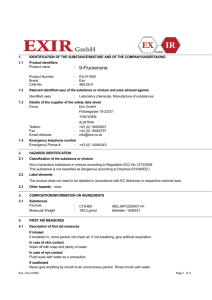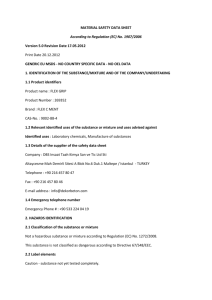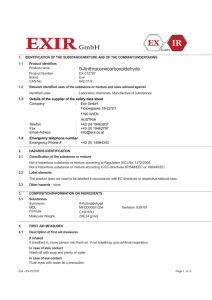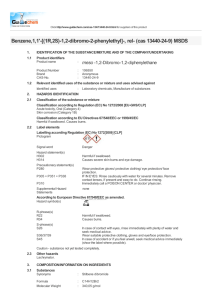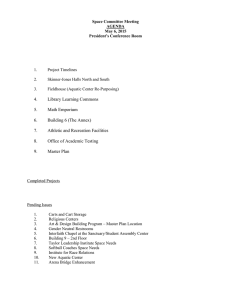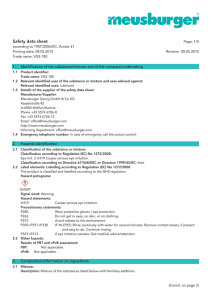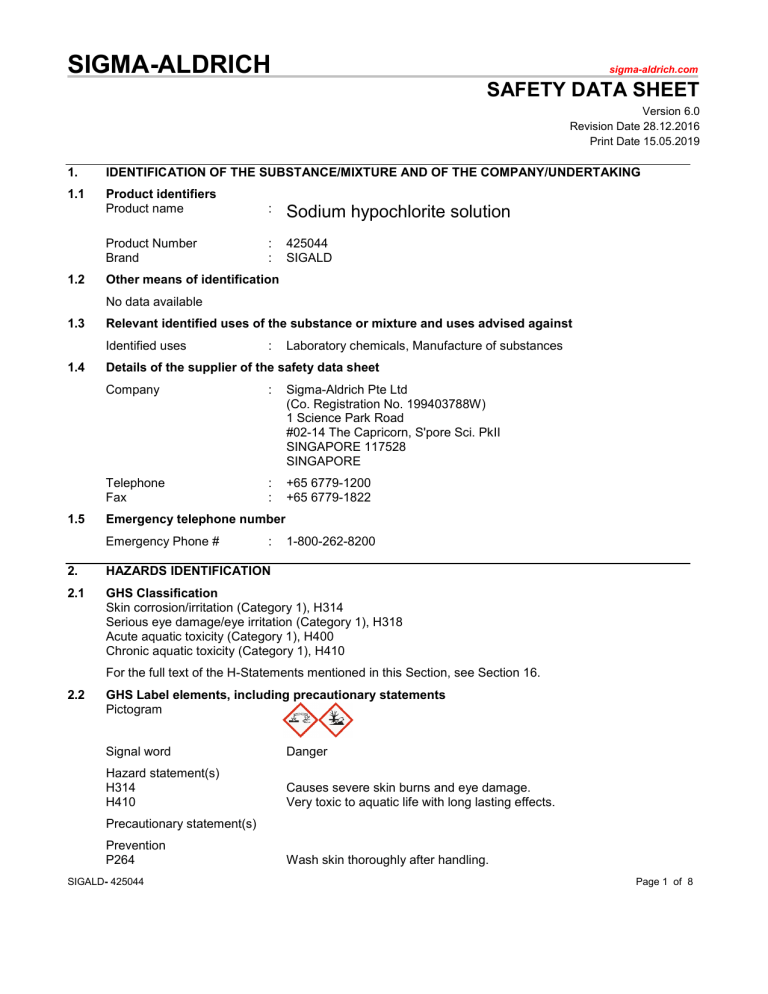
SIGMA-ALDRICH sigma-aldrich.com SAFETY DATA SHEET Version 6.0 Revision Date 28.12.2016 Print Date 15.05.2019 1. IDENTIFICATION OF THE SUBSTANCE/MIXTURE AND OF THE COMPANY/UNDERTAKING 1.1 Product identifiers Product name : Sodium hypochlorite solution Product Number Brand : : 425044 SIGALD 1.2 Other means of identification No data available 1.3 Relevant identified uses of the substance or mixture and uses advised against Identified uses 1.4 1.5 : Laboratory chemicals, Manufacture of substances Details of the supplier of the safety data sheet Company : Sigma-Aldrich Pte Ltd (Co. Registration No. 199403788W) 1 Science Park Road #02-14 The Capricorn, S'pore Sci. PkII SINGAPORE 117528 SINGAPORE Telephone Fax : : +65 6779-1200 +65 6779-1822 Emergency telephone number Emergency Phone # : 1-800-262-8200 2. HAZARDS IDENTIFICATION 2.1 GHS Classification Skin corrosion/irritation (Category 1), H314 Serious eye damage/eye irritation (Category 1), H318 Acute aquatic toxicity (Category 1), H400 Chronic aquatic toxicity (Category 1), H410 For the full text of the H-Statements mentioned in this Section, see Section 16. 2.2 GHS Label elements, including precautionary statements Pictogram Signal word Danger Hazard statement(s) H314 H410 Causes severe skin burns and eye damage. Very toxic to aquatic life with long lasting effects. Precautionary statement(s) Prevention P264 SIGALD- 425044 Wash skin thoroughly after handling. Page 1 of 8 P273 P280 Avoid release to the environment. Wear protective gloves/ protective clothing/ eye protection/ face protection. Response P301 + P330 + P331 P303 + P361 + P353 P391 IF SWALLOWED: Rinse mouth. Do NOT induce vomiting. IF ON SKIN (or hair): Remove/ Take off immediately all contaminated clothing. Rinse skin with water/ shower. IF INHALED: Remove victim to fresh air and keep at rest in a position comfortable for breathing. Immediately call a POISON CENTER or doctor/ physician. IF IN EYES: Rinse cautiously with water for several minutes. Remove contact lenses, if present and easy to do. Continue rinsing. Immediately call a POISON CENTER/doctor. Collect spillage. Storage P405 Store locked up. Disposal P501 Dispose of contents/ container to an approved waste disposal plant. P304 + P340 + P310 P305 + P351 + P338 + P310 2.3 Other hazards Contact with acids liberates toxic gas. 3. COMPOSITION/INFORMATION ON INGREDIENTS 3.2 Mixtures Chemical characterization Formula Molecular weight : : : KCL gloves information ClNaO 74,44 g/mol Component Sodium hypochlorite CAS-No. EC-No. Index-No. 7681-52-9 231-668-3 017-011-00-1 Classification Concentration 1; 2; Aquatic Acute 1; H314, H319, H400 M-Factor - Aquatic Acute: 10 >= 10 - < 20 % For the full text of the H-Statements mentioned in this Section, see Section 16. 4. FIRST AID MEASURES 4.1 Description of first aid measures General advice Consult a physician. Show this safety data sheet to the doctor in attendance. If inhaled If breathed in, move person into fresh air. If not breathing, give artificial respiration. Consult a physician. In case of skin contact Take off contaminated clothing and shoes immediately. Wash off with soap and plenty of water. Consult a physician. In case of eye contact Rinse thoroughly with plenty of water for at least 15 minutes and consult a physician. If swallowed Do NOT induce vomiting. Never give anything by mouth to an unconscious person. Rinse mouth with water. Consult a physician. SIGALD- 425044 Page 2 of 8 4.2 Most important symptoms and effects, both acute and delayed The most important known symptoms and effects are described in the labelling (see section 2.2) and/or in section 11 4.3 Indication of any immediate medical attention and special treatment needed No data available 5. FIREFIGHTING MEASURES 5.1 Extinguishing media Suitable extinguishing media Dry powder 5.2 Special hazards arising from the substance or mixture Hydrogen chloride gas, Sodium oxides 5.3 Advice for firefighters Wear self-contained breathing apparatus for firefighting if necessary. 5.4 Further information No data available 6. ACCIDENTAL RELEASE MEASURES 6.1 Personal precautions, protective equipment and emergency procedures Wear respiratory protection. Avoid breathing vapours, mist or gas. Ensure adequate ventilation. Evacuate personnel to safe areas. For personal protection see section 8. 6.2 Environmental precautions Prevent further leakage or spillage if safe to do so. Do not let product enter drains. Discharge into the environment must be avoided. 6.3 Methods and materials for containment and cleaning up Soak up with inert absorbent material and dispose of as hazardous waste. Do not flush with water. Keep in suitable, closed containers for disposal. 6.4 Reference to other sections For disposal see section 13. 7. HANDLING AND STORAGE 7.1 Precautions for safe handling Avoid inhalation of vapour or mist. For precautions see section 2.2. 7.2 Conditions for safe storage, including any incompatibilities Store in cool place. Keep container tightly closed in a dry and well-ventilated place. Containers which are opened must be carefully resealed and kept upright to prevent leakage. Never allow product to get in contact with water during storage. Do not store near acids. Recommended storage temperature 2 - 8 °C 7.3 Specific end use(s) Apart from the uses mentioned in section 1.2 no other specific uses are stipulated SIGALD- 425044 Page 3 of 8 8. EXPOSURE CONTROLS/PERSONAL PROTECTION 8.1 Control parameters Components with workplace control parameters 8.2 Exposure controls Appropriate engineering controls Handle in accordance with good industrial hygiene and safety practice. Wash hands before breaks and at the end of workday. Personal protective equipment Eye/face protection Tightly fitting safety goggles. Faceshield (8-inch minimum). Use equipment for eye protection tested and approved under appropriate government standards such as NIOSH (US) or EN 166(EU). Skin protection Handle with gloves. Gloves must be inspected prior to use. Use proper glove removal technique (without touching glove's outer surface) to avoid skin contact with this product. Dispose of contaminated gloves after use in accordance with applicable laws and good laboratory practices. Wash and dry hands. The selected protective gloves have to satisfy the specifications of EU Directive 89/686/EEC and the standard EN 374 derived from it. Full contact Material: Nitrile rubber Minimum layer thickness: 0,11 mm Break through time: 480 min Material tested:Dermatril® (KCL 740 / Aldrich Z677272, Size M) Splash contact Material: Nitrile rubber Minimum layer thickness: 0,11 mm Break through time: 480 min Material tested:Dermatril® (KCL 740 / Aldrich Z677272, Size M) data source: KCL GmbH, D-36124 Eichenzell, phone +49 (0)6659 87300, e-mail sales@kcl.de, test method: EN374 If used in solution, or mixed with other substances, and under conditions which differ from EN 374, contact the supplier of the CE approved gloves. This recommendation is advisory only and must be evaluated by an industria situation of anticipated use by our customers. It should not be construed as offering an approval for any specific use scenario. Body Protection Complete suit protecting against chemicals, The type of protective equipment must be selected according to the concentration and amount of the dangerous substance at the specific workplace. Respiratory protection Where risk assessment shows air-purifying respirators are appropriate use (US) or type ABEK (EN 14387) respirator cartridges as a backup to enginee protection, use a full-face supplied air respirator. Use respirators and components tested and approved under appropriate government standards such as NIOSH (US) or CEN (EU). Control of environmental exposure Prevent further leakage or spillage if safe to do so. Do not let product enter drains. Discharge into the environment must be avoided. SIGALD- 425044 Page 4 of 8 9. PHYSICAL AND CHEMICAL PROPERTIES 9.1 Information on basic physical and chemical properties a) Appearance Form: liquid b) Odour No data available c) Odour Threshold No data available d) pH No data available e) Melting point/freezing point -30 - -20 °C f) Initial boiling point and boiling range 111 °C g) Flash point Not applicable h) Evaporation rate No data available i) Flammability (solid, gas) No data available j) Upper/lower flammability or explosive limits No data available k) Vapour pressure 17,5 mmHg at 20 °C l) Vapour density No data available m) Relative density 1,206 g/mL at 25 °C n) Water solubility completely miscible o) Partition coefficient: noctanol/water No data available p) Auto-ignition temperature No data available q) Decomposition temperature No data available r) Viscosity No data available s) Explosive properties No data available t) Oxidizing properties No data available 9.2 Other safety information No data available 10. STABILITY AND REACTIVITY 10.1 Reactivity No data available 10.2 Chemical stability Stable under recommended storage conditions. 10.3 Possibility of hazardous reactions No data available 10.4 Conditions to avoid No data available SIGALD- 425044 Page 5 of 8 10.5 Incompatible materials Strong acids, Organic materials, Powdered metals, Forms shock-sensitive mixtures with certain other materials., Amines, Reacts violently with ammonium salts, aziridine, methanol, and phenylaceto unstable n-chlor 55°C. 10.6 Hazardous decomposition products Hazardous decomposition products formed under fire conditions. - Hydrogen chloride gas, Sodium oxides Other decomposition products - No data available In the event of fire: see section 5 11. TOXICOLOGICAL INFORMATION 11.1 Information on toxicological effects Acute toxicity No data available Skin corrosion/irritation No data available Serious eye damage/eye irritation No data available Respiratory or skin sensitisation No data available Germ cell mutagenicity No data available Carcinogenicity IARC: A4 - Not classifiable as a human carcinogen (Sodium hypochlorite) 3 - Group 3: Not classifiable as to its carcinogenicity to humans (Sodium hypochlorite) Reproductive toxicity No data available Specific target organ toxicity - single exposure No data available Specific target organ toxicity - repeated exposure No data available Aspiration hazard No data available Additional Information RTECS: Not available burning sensation, Cough, wheezing, laryngitis, Shortness of breath, spasm, inflammation and edema of the larynx, spasm, inflammation and edema of the bronchi, pneumonitis, pulmonary edema, Material is extremely destructive to tissue of the mucous membranes and upper respiratory tract, eyes, and skin., To the best of our knowledge, the chemical, physical, and toxicological properties have not been thoroughly investigated. 12. ECOLOGICAL INFORMATION 12.1 Toxicity No data available 12.2 Persistence and degradability No data available SIGALD- 425044 Page 6 of 8 12.3 Bioaccumulative potential No data available 12.4 Mobility in soil No data available 12.5 Results of PBT and vPvB assessment PBT/vPvB assessment not available as chemical safety assessment not required/not conducted 12.6 Other adverse effects Very toxic to aquatic life with long lasting effects. 13. DISPOSAL CONSIDERATIONS 13.1 Waste treatment methods Product Offer surplus and non-recyclable solutions to a licensed disposal company. Contaminated packaging Dispose of as unused product. 14. TRANSPORT INFORMATION 14.1 UN number ADR/RID: 1791 IMDG: 1791 IATA-DGR: 1791 14.2 UN proper shipping name ADR/RID: HYPOCHLORITE SOLUTION IMDG: HYPOCHLORITE SOLUTION IATAHypochlorite solution DGR: Passenger Aircraft: Not permitted for transport Cargo Aircraft: Not permitted for transport 14.3 Transport hazard class(es) ADR/RID: 8 IMDG: 8 IATA-DGR: 8 Packaging group ADR/RID: III IMDG: III IATA-DGR: III Environmental hazards ADR/RID: no IMDG Marine pollutant: no IATA-DGR: no 14.4 14.5 14.6 Special precautions for user No data available 15. REGULATORY INFORMATION 15.1 Safety, health and environmental regulations/legislation specific for the substance or mixture No data available 16. OTHER INFORMATION Full text of H-Statements referred to under sections 2 and 3. H314 H318 H319 H400 H410 SIGALD- 425044 Causes severe skin burns and eye damage. Causes serious eye damage. Causes serious eye irritation. Very toxic to aquatic life. Very toxic to aquatic life with long lasting effects. Page 7 of 8 Further information Copyright 2016 Sigma-Aldrich Co. LLC. License granted to make unlimited paper copies for internal use only. The above information is believed to be correct but does not purport to be all inclusive and shall be used only as a guide. The information in this document is based on the present state of our knowledge and is applicable to the product with regard to appropriate safety precautions. It does not represent any guarantee of the properties of the product. Sigma-Aldrich Corporation and its Affiliates shall not be held liable for any damage resulting from handling or from contact with the above product. See www.sigmaaldrich.com and/or the reverse side of invoice or packing slip for additional terms and conditions of sale. SIGALD- 425044 Page 8 of 8
